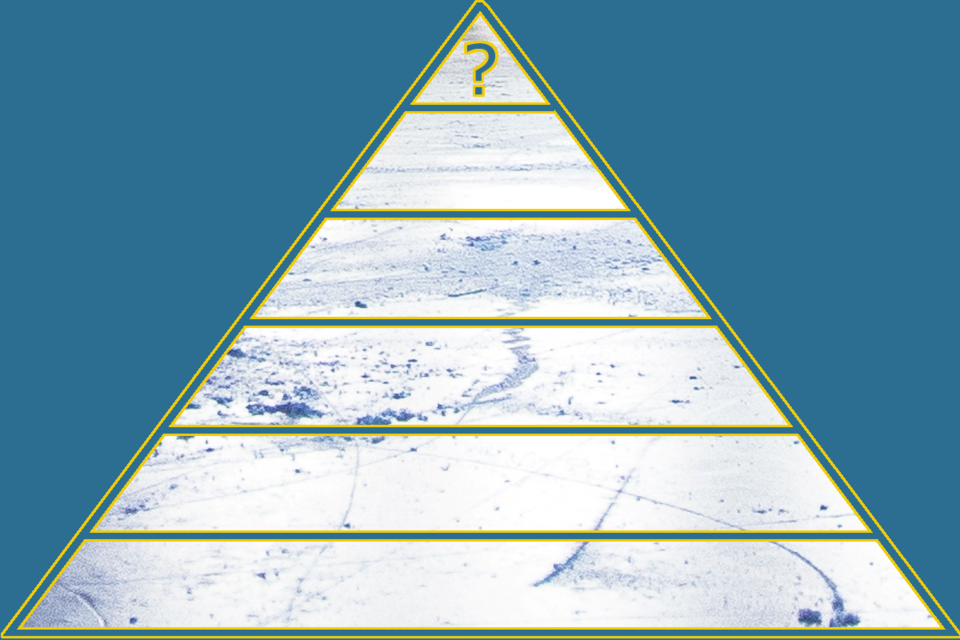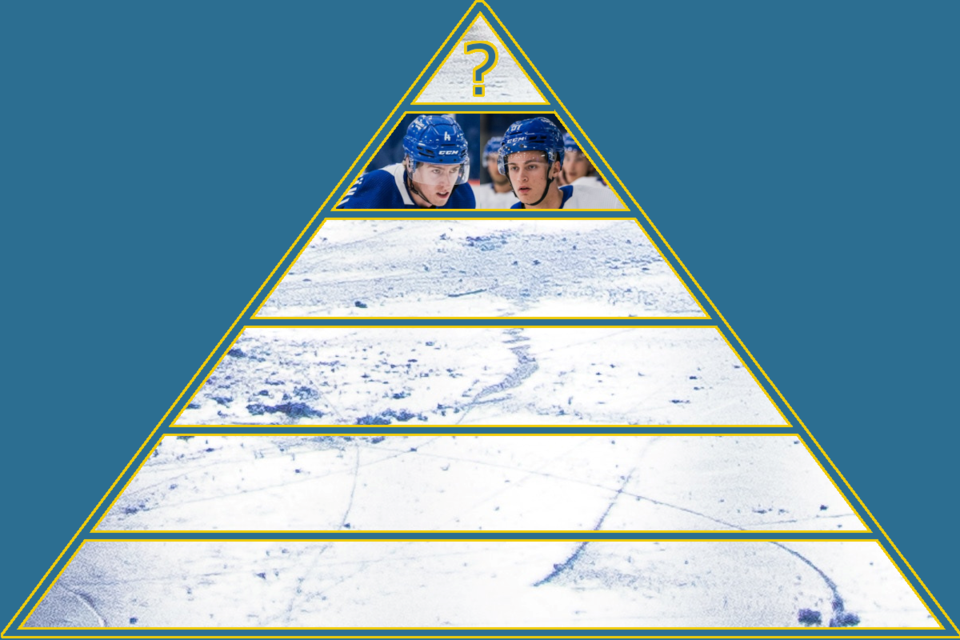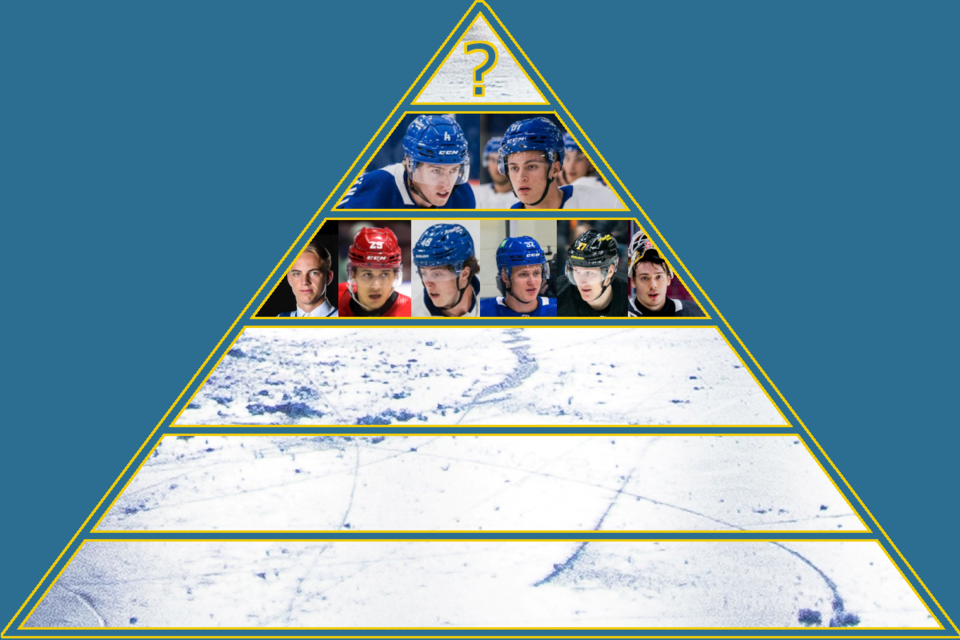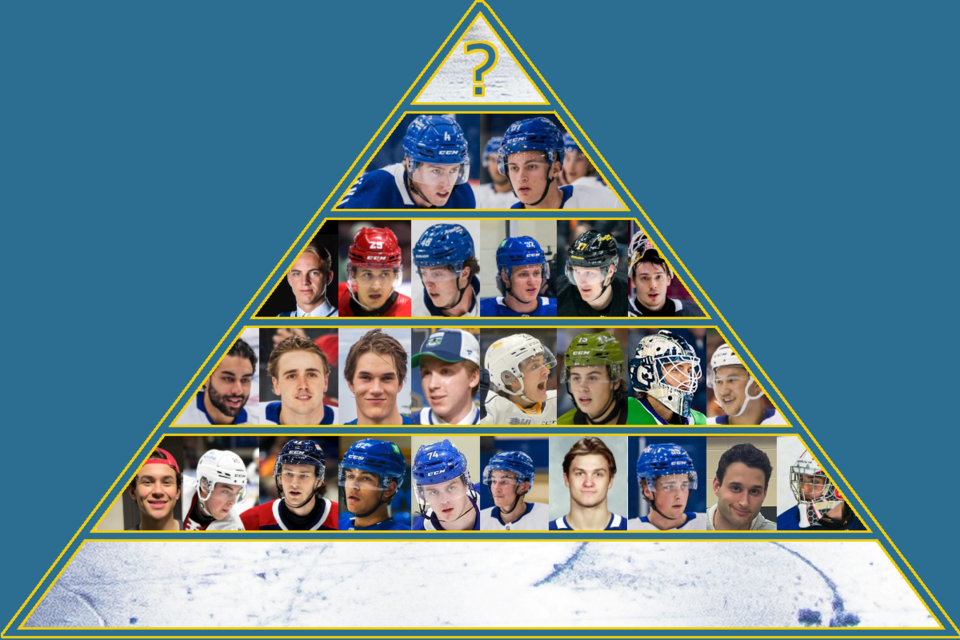The time has come to rank the Vancouver Canucks’ prospects using one of the greatest architectural designs in human history: the noble pyramid.
The typical format for a prospect ranking is a numbered list, which is all well and good, but it requires far too much splitting of hairs. What does it mean that one player is the 19th best prospect in a system and another is the 20th best? What distinguishes the two prospects at that point?
It’s particularly difficult to split those hairs when you’re talking about players in different positions at different ages and different stages in their careers. Is AHL forward Max Sasson a better prospect than WHL goaltender Ty Young? Who can possibly say?
The prospect pyramid, developed by content creator and professional yeller Steve Dangle, alleviates these issues. Instead of ranking prospects from one to 30, it ranks them in tiers.
This naturally results in a triangular shape: one or two (or zero) blue-chip prospects at the top, a few great prospects, several more good prospects, a big group of average or decent prospects, and then a whole bunch of longshots or projects.
Where do the Canucks’ prospects fit into the pyramid? Let’s build the pyramid the way the aliens did: from the top down.
Tier 1 - Nobody, sorry

The top tier of the pyramid is for true blue-chip prospects: the types of can’t-miss players who are not only a lock to make the NHL but are likely to be legitimate stars. We’re talking about the likes of Elias Pettersson, Quinn Hughes, and Thatcher Demko: future first-line forwards, top-pairing defencemen, or number one goaltenders with the potential of becoming franchise stars.
Right now, the Canucks don’t have any of those.
That’s not too surprising. The Canucks have only made two first-round picks in the last five years and both of those picks were outside of the top ten.
There’s always a chance that one of their top prospects exceeds expectations and becomes a legitimate star but, for now, the Canucks don’t have anyone in the top tier of their prospect pyramid.
Tier 2 - Lekkerimäki and Willander

The second tier of the pyramid is reserved for prospects with the potential to be a top-four defenceman, a top-six forward, or a starting goaltender in the NHL and an excellent chance of reaching that potential. They might even have an outside chance of being a star player but lower odds of reaching that potential compared to a tier-one prospect.
The Canucks have two prospects that fit the bill.
Jonathan Lekkerimäki
After a brutal post-draft season in the HockeyAllsvenskan, Jonathan Lekkerimäki responded with an excellent year in the SHL. He led Örebro with 19 goals and 31 points in 46 games, producing despite limited offensive support.
That was enough to lead all junior-aged players in scoring in the SHL, eight points clear of former teammate Noah Östlund in second place. In fact, it’s the 18th-best season all-time by a junior-aged player in the SHL and the third-best in the last ten years behind Elias Pettersson and Pittsburgh Penguins forward Emil Bemström. Unsurprisingly, he was named rookie of the year and the Swedish Junior Hockey Player of the Year.
Lekkerimäki also led the World Juniors in goals with 7 in 7 games and was named the tournament’s most valuable player.
With all of that put together, Lekkerimäki nearly earned his way into Tier 1 on the pyramid, but there are still some lingering questions about how Lekkerimäki’s game will translate to the NHL. He’s a sniper who can score from distance but that can lead to a lot of perimeter play that won’t produce results on NHL ice. Combine that with a slight build and it could be a rough transition for Lekkerimäki as he plays his first season in North America.
Still, Lekkerimäki has the potential to be a top-six winger in the NHL and could play games for the Canucks as early as this coming season.
Tom Willander
Tom Willander may not have dazzled in his freshman season at Boston University, but he was solid. The right-shot defenceman put up 25 points in 38 games while adapting his smooth-skating defensive game to the smaller ice surface in North America. His ability to close gaps and divest opponents of the puck makes him a virtual lock to make the NHL and will likely land him in a top-four role once he gets there.
While Willander isn’t quite a blue-chipper, he’s pretty close to a sure thing to play in the NHL, which is a rarity in the Canucks’ prospect pool right now. Once he reaches the NHL, Willander should be at least a second-pairing defenceman thanks to his mobility, physicality, and defensive hockey IQ.
Depending on how his still-raw puck skills develop, however, Willander could also end up as a complementary partner on a top pair or a two-way play-driver on his own merits.
Tier 3 - Silovs and friends

A prospect in tier 3 might have a good shot of becoming an NHL player but is more likely to be a bottom-six forward, third-pairing defenceman, or a backup goaltender. Alternately, a prospect in this tier might have the potential to be a top-six forward, top-four defenceman, or starting goaltender but is less likely to reach that potential.
Melvin Fernström
The Canucks’ top pick in the 2024 NHL Entry Draft didn’t come until the third round but Melvin Fernström has some legitimate top-six potential thanks to his hockey IQ. He’s a great goalscorer, who is adept at finding open space in the offensive zone.
The issue is that he has some significant flaws that are going to make it difficult for him to reach that potential, particularly his skating. That could be a major obstacle to him getting to the NHL. Fernström is a boom-or-bust prospect, whose future depends on how he addresses the flaws in his game.
Kirill Kudryavtsev
I am quite high on Kirill Kudryavtsev, a versatile puck-moving defenceman who plays a pro-style game. He’s constantly layering deception into everything he does, whether retrieving the puck against the forecheck or passing the puck in transition. That’s going to be essential for transitioning to the NHL level.
Combine that with his smooth-skating, gap-closing defensive game and Kudryavtsev seems like a strong bet to be a third-pairing defenceman in the future.
Cole McWard
Among the Canucks’ prospect defencemen, Cole McWard might be the best bet to play the most NHL games next season. While his numbers from his rookie season in the AHL — 17 points in 57 games — don’t jump off the page but he took significant steps in the defensive side of his game, which will have a bigger impact on how soon he gets into the Canucks’ lineup.
Unless there are injuries, McWard won’t be making the Canucks out of camp, but he’ll be battling to be the first call-up from Abbotsford.
Elias Pettersson
In terms of future potential among the defencemen, however, the younger Elias Pettersson is second only to Tom Willander in the Canucks’ system. The heavy-hitting Pettersson won’t put up a lot of points but his combination of size and skating ought to lead to a shutdown role in the future.
I lean more towards him having third-pairing potential but there’s a chance Pettersson can turn into a solid, second-pairing player. He might even earn a call-up in his rookie season in North America.
Aatu Räty
After the first-round pick that turned into Filip Hronek, Aatu Räty was the second biggest part of the Bo Horvat trade with the New York Islanders. Despite already playing 15 NHL games heading into this past season, Räty spent the whole season in the AHL with the Abbotsford Canucks, without even a hint of him potentially getting called up.
That was probably for the best, as it reduced the pressure on Räty and allowed him to focus on growing his game. He put up 52 points in 72 games in Abbotsford and developed the two-way game that is likely to get him to the NHL in a bottom-six role more than his scoring. The 21-year-old forward will likely be a call-up option next season, capable of providing some depth scoring.
Arturs Silovs
Canucks fans might disagree with Arturs Silovs being in Tier 3 after his playoff performance but this is the appropriate tier for a prospect whose most likely future is as a backup goaltender in the NHL.
Silovs was solid in the AHL for the Abbotsford Canucks and performed heroically in the Stanley Cup Playoffs in the difficult position of coming in as the third-string goaltender after injuries to Thatcher Demko and Casey DeSmith. Combine that with his MVP performance for Latvia in the World Championship to win the bronze medal and it’s understandable why fans are excited about Silovs.
But it’s important to keep in mind that Silovs still only had an .881 save percentage in his four regular season games in the NHL and an .898 save percentage in the playoffs. He made some huge saves but he sometimes struggled to track shots through traffic. In the AHL, he had a .907 save percentage, which was basically league average.
There’s certainly reason to believe he can improve on those numbers but it’s very much up in the air whether Silovs can become more than a backup at the NHL level. He still has a lot to prove.
Tier 4 - Goaltending depth and intriguing prospects

Prospects in Tier 4 might make the NHL but they either have a long road ahead of them or a lot of uncertainty surrounding their potential. Maybe they’ll be a fourth-line forward, a seventh defenceman, or a bubble backup — maybe they’ll be more than that — it’s just not clear.
Arshdeep Bains
While some seem certain Arshdeep Bains is bound for the NHL, I’m on the fence. While he’s developed well in Abbotsford, Bains struggled with the pace of the NHL at times in his eight games last season. Ultimately, he was on the ice for the highest rate of goals against at 5-on-5 on the team.
Still, Bains had 55 points in 59 games in the AHL and executes on the little details that a coach like Rick Tocchet demands, so he’s almost certain to get another shot sometime next season. With the experience of already playing some NHL games, maybe he can take the next step.
Linus Karlsson
Similarly, I’m on the fence with Linus Karlsson. The Canucks clearly like him — they even briefly put him on a line with Elias Pettersson in the playoffs — and he was a point-per-game player in the AHL with 60 points in 60 games. On the other hand, he’s about to turn 25 and has played just six games in the NHL.
I’m just not sure who Karlsson is at the NHL level, which leaves him in Tier 4 with a whole bunch of question marks. This will be a big season for him to prove he belongs in an NHL lineup.
Aku Koskenvuo
It seemed like goaltender Aku Koskenvuo had stalled in his development at Harvard University after playing just two games in his freshman season, but he played significantly better last season in his sophomore year. Koskenvuo split starts with senior Derek Mullahy and thoroughly outplayed him, with a .910 save percentage in 17 games compared to Mullahy’s .897.
His signature performance came near the end of the year, where he put together a 38-save shutout against Princeton, after which he matter-of-factly said, “Well, we needed the win. I needed to stop all of the pucks because we only had one goal.”
This coming season will be a telling one for Koskenvuo, as he’ll finally get the opportunity to be the number one goaltender for Harvard, though he’ll have to fend off AJHL goaltender of the year Ben Charette, who will be joining the program for his freshman year.
Sawyer Mynio
Sawyer Mynio had a great post-draft season for the Seattle Thunderbirds, tallying 16 goals and 53 points in 63 games, good for 13th in scoring among WHL defencemen. There’s a lot to like about his well-rounded two-way game, as he’s added offensive upside to his already strong defensive game at the junior level.
Still, Mynio’s upside leans more toward the bottom-pairing and he needs to add more size and strength to effectively compete for pucks in the NHL. That leaves Mynio with a long path ahead of him, though he’s taken some very promising steps along that path.
Riley Patterson
With his speed and skill, Riley Patterson was a great bet for the Canucks to make in the fourth round of the 2024 draft. He put up 62 points in 68 games for the Barrie Colts in the OHL, with NHL-caliber tools in terms of his skating, shot, and puckhandling.
What’s lacking for Patterson is that he’s not yet a consistent play-driver. His offence comes in flashes and when he’s not attacking in transition, he’s not always contributing. If he can develop better consistency, he’s got the potential to be a third-line forward, perhaps even at the valuable centre position, but he’s got a lot of work to do.
Anthony Romani
Anthony Romani was one of the Canucks’ most intriguing home run swings at the 2024 draft, getting the OHL’s leading goalscorer in the sixth round, albeit in his second year of draft eligibility.
Romani has high-end potential but there’s a reason why he was a sixth-round pick. He’ll need to develop his skating, puck protection, and his defensive game to move up the prospect rankings and eventually make the NHL.
Nikita Tolopilo
Nikita Tolopilo had decent rookie season in the AHL, his first in North America. The 6’6” goaltender played 35 games for the Abbotsford Canucks and posted a .905 save percentage. He’s cool, calm, and collected in net, though he’ll need to continue to make adjustments to close up holes in his stance that NHL shooters could exploit.
It seems like Tolopilo has what it takes to be an AHL starter but it’s not clear yet if he can be anything more. With Silovs likely to be Thatcher Demko’s backup in Vancouver, Tolopilo will battle with Jiri Patera for starts in Abbotsford and also to be the call-up if injuries occur.
Jett Woo
Development is rarely smooth and easy and no one in the Canucks organization illustrates that more than Jett Woo. He was a near write-off as a prospect a couple of years ago but he turned his game around and has become a key part of the Abbotsford Canucks’ blue line.
This past season, Woo put up 31 points in 62 games while playing in all situations in Abbotsford and even earned a call-up to Vancouver, though he didn’t get into a game. He and Cole McWard will battle for ice time and for a call-up next season and, while I lean toward McWard, I wouldn’t count Woo out.
Tier 5 - Depth and potential

In Tier 5, we have prospects whose potential veers in the direction of being a bubble player — depth forward, depth defenceman, or AHL goaltender — but with the right development maybe they could be something more.
Parker Alcos
Parker Alcos might be a hidden gem from the 2024 draft, with some suggesting the sixth-round pick has more offensive upside than his 1 goal and 15 points in 67 WHL games would suggest. Now the defensive defenceman has to prove that’s true and illustrate that he has the puck skills that could lead to an NHL future.
Vilmer Alriksson
With his size and smooth skating, it’s hard to avoid being overly optimistic about Vilmer Alriksson. The 6’6” winger has the potential to be a power forward but he’s got a long path ahead of him. He had just 33 points in 67 games in his post-draft season, his first in the OHL, which should temper expectations a bit.
Josh Bloom
Josh Bloom started last season with the Abbotsford Canucks in the AHL but underwhelmed, even getting sent down to the ECHL for eight games, where he had just 2 points in 8 games. Eventually, he was re-assigned to the Saginaw Spirit in the OHL to play as an over-ager in the OHL.
That inability to stay up in the AHL might be a bit of a red flag but he did have a decent season in the OHL, putting up 40 points in 34 games before scoring the Memorial Cup-winning goal for the Saginaw Spirit. He’ll be back in Abbotsford this coming season and will look to make a stronger impression.
Jackson Dorrington
It’s tough for a prospect to make the NHL without a defining element in their skillset — something that stands out as a key strength that a game can be built around — which is why Jackson Dorrington is tough to project. The 6’2” defenceman is a jack-of-all-trades, master-of-none type of player who does a little bit of everything well but doesn’t excel in any one area.
At the same time, when the only criticism is that he does everything well, maybe that's not a bad thing.
Lucas Forsell
There are some who are high on Lucas Forsell, whose game seemed to be growing by leaps and bounds after the Canucks drafted him in the seventh round in 2021. I’m a little more skeptical, particularly after he took a step backward in the SHL this past season, managing just 4 goals and 7 points in 46 games.
Limited ice time certainly played a role, as Forsell averaged just 9:24 per game, the lowest ice time among Färjestad regulars. But some of that has to land on Forsell not demanding more ice time with his play three seasons after being drafted. He’s gone from being seemingly a sure thing to earn a contract with the Canucks to more of a longshot.
Akito Hirose
Akito Hirose looked a hair’s breath from being an NHLer when he joined the Canucks at the tail end of the 2022-23 season but his rookie year with the Abbotsford Canucks in the AHL was thoroughly underwhelming. While offence isn’t going to be his calling card, just 2 points in 33 games isn’t great and he didn’t stand out as exceptional defensively either.
Considering his size and that he’s already 25, he’s bordering on not being a prospect anymore. Am I being too harsh dropping him all the way to Tier 5? Maybe but this will be an important season for him to prove he can be more than just a depth defenceman.
Danila Klimovich
There’s no getting around how disappointing this past season was for Danila Klimovich. In his third season in the AHL, the 21-year-old failed to build on the 17 goals and 29 points he scored last season. Instead, he had just 4 points in 24 games and was a frequent healthy scratch.
There’s still raw talent there but at this point that raw talent should have become a little more refined. He’ll be looking for a bounceback season to prove he still has NHL potential.
Ty Mueller
Like Dorrington, Ty Mueller is a bit of a jack-of-all-trades, master-of-none player, just as a forward instead of a defenceman. He’s a two-way centre who can also play on the wing and has a high workrate that will likely make him a favourite of his new head coach, Manny Malhotra, in Abbotsford. We’ll see if Malhotra can help him turn that into a bottom-six NHL future.
Max Sasson
Max Sasson could very well play games for the Canucks next season after a strong rookie year in Abbotsford where he posted 18 goals and 42 points in 56 games. The 23-year-old forward has the workrate and tenacity to carve out a role as a fourth-line centre in the future but has yet to prove he can handle NHL pace.
As one of the few pure centres in Abbotsford, however, Sasson could end up top of the queue for a call-up should injuries strike in Vancouver. The question is whether he can be an NHLer long-term or if his future is as a depth forward in the AHL.
Ty Young
It’s tough to know what to make of Ty Young, who has the size and athleticism to be an NHL goaltender but has middling numbers in junior. This past season was his best in terms of save percentage with a .903 but he actually lost his starting job with the Prince George Cougars in the WHL to top prospect Joshua Ravensbergen.
The Canucks’ goaltending coaches are high on Young’s potential but he’s a long way from the NHL.
Tier 6 - Everyone Else

This is the tier for every other prospect in the Canucks’ system. The odds are against these players making the NHL but there’s always a chance that they could take big leaps in their development.
Maybe we could see some prospects break out of this tier, like homegrown defenceman Aiden Celebrini, Swedish defenceman Hugo Gabrielson, 6’4” NCAA centre Daimon Gardner, or longshot seventh-round pick Basile Sansonnens.
For now, it’s simply safe to say that these prospects have a lot of work ahead of them.



